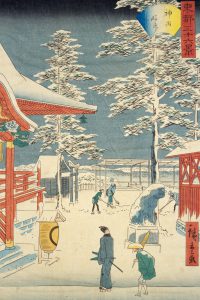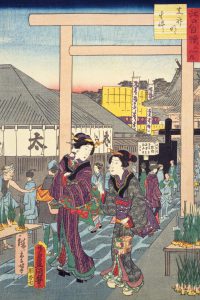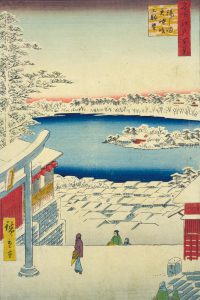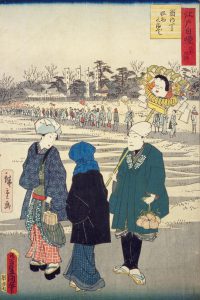Shrine and temple information
[Kanda Myojin Shrine]
2-16-2, Sotokanda, Chiyoda Ward, Tokyo.

After Ieyasu prayed for victory at the shrine in the Battle of Sekigahara, his army achieved it on 15 September, the day of the Kanda Festival. It became the guardian shrine of Edo Castle after the establishment of the Tokugawa shogunate, relocated from Otemachi to its present site where the Kimon gate of the castle (in the northeast and considered to be lucky) stood and became the place that enshrined the Grand Guardian Gods of Edo. The Kanda Festival was a Goyomatsuri (a state festival) observed by the Shogun. Samurais such as Taira no Masakado are enshrined there.
[Hie Shrine]
2-10-5, Nagatacho, Chiyoda Ward, Tokyo.
When Dokan Ohta built Edo Castle, he invited the Hie Shrine of Kawagoe to move there. Ieyasu was also deified as the castle’s defender and guardian deity of his birthplace. The shrine became familiar to ordinary folks when the second Tokugawa Shogun, Hidetaka, relocated it outside the castle. It was damaged by the Great Fire of Meireki and was rebuilt in its present location by the Urakimon (to the southwest) of Edo Castle by the fourth Tokugawa Shogun, Ietsuna. The Sanno Festival of the shrine is held biennially with Kanda Festival.
[Shiba Daijingu Shrine]
1-12-7, Shibadaimon, Minato Ward, Tokyo.

The shrine prospered as “the Ise of Kanto” under the shogunate’s protection. It is where the kabuki play “Megumi no Kenka” is set. Its regular festival held between 11 and 21 September is called “Dara-Dara Matsuri” which is famous for its ginger market and “Chigibako.” Chigibako are popular among women as they are believed to increase a kimono collection when placed inside your chest of drawers.
[Zojoji Temple]
4-7-35, Shibakoen, Minato Ward, Tokyo.
This is the family temple of the Tokugawa clan. It was initially located in Kaizuka (present-day Hirakawacho area in Chiyoda Ward), but it was given a temple estate worth 10,000 Koku in 1598. A school and training facility for priests was established there, and legend has it that it was home to 3,000 priests. It houses the tombstones of six Shoguns, from the second Shogun Hidetada onwards.
[Sengakuji Temple]
2-11-1, Takanawa, Minato Ward, Tokyo.
The temple is famous for being the burial site of the loyal retainers of Ako of “Chushingura.” It was built by Ieyasu but was lost in the Great Fire of Kanei. The third Shogun Iemitsu ordered the five top feudal lords, Mouri, Asano, Kuchiki, Tamba, and Mizutani to rebuild the temple on its present site. It became the family temple of the Asano clan of Ako for this association. The Gishi Festival is held at the beginning of April and on 14 December, marking the day of the raid.
[Nezu Shrine]
1-28-9, Nezu, Bunkyo Ward, Tokyo.
When the fifth Shogun Tsunayoshi made his brother Tsunashige’s son Ienobu his heir, he donated property to Nezu Shrine, which is dedicated to the guardian deity of Ienobu’s birthplace and built a shrine by order of Tenka Bunshin (public works project). It has a spectacular azalea garden which dates back to the flowering shrub planted by Tsunashige. The festival held at the temple was an official ceremony during the reign of Ienobu and Ietsugu, but it became a festival for ordinary folks from Yoshimune’s era onwards.
[Yushima Tenmangu Shrine (Tenjin)]
3-30-1, Yushima, Bunkyo Ward, Tokyo.

The shrine is dedicated to the deity of learning, Michizane Sugawara. Many literati and academics such as Hakuseki Arai and Razan Hayashi, as well as members of the Tokugawa family, worshipped at the shrine during the Edo period. The good-luck draw show, the origin of the lottery, was also actively performed and it was popular among common folks as one of the “three fortunes of Edo.” The site is famous for its plum blossoms.
[Kaneiji Temple]
1-14-11, Ueno Sakuragi, Taito Ward, Tokyo.

The second Shogun Hidetada granted Ueno at Edo Castle’s Kimon gate (in the northeast and considered to be auspicious) to Priest Tenkai, and the third Shogun Iemitsu had the temple built. It became the family temple of the Tokugawas alongside Zojoji after Iemitsu’s funeral was held there. It is the final resting place of six Shoguns. The grounds were twice the size of Ueno Park in the temple’s heyday. Shinobazu Pond was created in the likeness of Lake Biwa and is famous for its lotuses.
[Asakusa Temple]
2-3-1, Asakusa, Taito Ward, Tokyo.
The temple dates back to the Asuka era when the local chief Nakatomo Haji proclaimed a statue caught in a fishing net cast by fishermen brothers Hamanari and Takenari Hinokuma to be that of the Deity of Mercy. He transformed his home into a temple to enshrine the statue. The whole of the northwest part of the main temple is called “Okuyama,” and it was Edo’s top entertainment district and the leading centre of culture.
[Asakusa Shrine]
2-3-1, Asakusa, Taito Ward, Tokyo.
Situated adjacent to Asakusa Temple, the shrine is dedicated to the Hinokuma brothers Hamanari and Takenari, and Nakatomo Haji as “Sanshasama.” It was originally a Gongensha Shrine on the grounds of Asakusa Temple, but it became a separate entity due to the Edict for Separation of Shinto and Buddhism during the Meiji era. The Sanshasai Festival dates back to the boat festival when a portable shrine was placed on a boat to cruise down the Sumida River, and Funatogyo (a procession of boats) was practised until the Edo period.
[Ohtori Shrine/Chokokuji Temple]
3-18-7, Senzoku, Taito Ward, Tokyo (Ohtori Shrine)/3-19-6 (Chokokuji Temple).

The shrine and temple are famous for the “Tori no Ichi” market where bamboo rakes believed to bring good luck are sold on the Day of the Rooster in November. The market was initially held in Ohtori Shrine in Hanahata, Adachi Ward, but the markets at Ohtori Shrine and Chokokuji Temple later gained prominence. It was situated on the west side of Shinyoshiwara, and the market’s popularity was propelled by the fact that all the gates of Shinyoshiwara opened on Tori no Ichi market day.
[Eko-in Temple]
2-8-10, Ryogoku, Sumida Ward, Tokyo.
The temple was built to console the souls of the family-less and friendless victims of the “Great Fire of Meireki which claimed over 100,000 lives. It attracted adoration as the temple that exhibited the hidden Buddhist images of famous temples across Japan in the mid-Edo period, and as the venue for fund-raising sumo matches in the late Edo times. It is the final resting place of Kyoden Santo and Jirokichi aka Nezumi Kozo.
[Kamedo Tenjin Shrine]
3-6-1. Kamedo, Koto Ward, Tokyo.

The fourth Shogun Ietsuna, who used the area of Honjo as the symbol of recovery from the Great Fire of Meireki, donated his land to defend the town. It was modelled after Dazaifu Tenmangu Shrine and was also called “The Dazaifu Tenmangu of the East.” It appears in ukiyo-e alongside Taiko Bridge.
[Tomioka Hachiman Shrine]
1-20-3, Tomioka, Koto Ward, Tokyo.
The shrine was built in the Kanrei era. It possessed nearly 200,000 square meters of land under Tokugawa’s protection. The area around its gate prospered as “Fukagawa’s Hachiman-san” (today’s Monzen Nakamachi.) It is where sumo matches for raising funds began in Edo. Fukagawa Festival is also known as “Mizukake (water splashing) Matsuri” in which onlookers splash bearers with purifying water.

